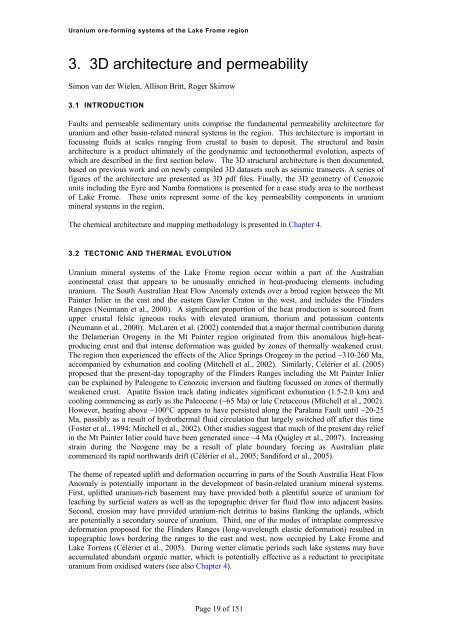Uranium ore-forming systems of the - Geoscience Australia
Uranium ore-forming systems of the - Geoscience Australia
Uranium ore-forming systems of the - Geoscience Australia
Create successful ePaper yourself
Turn your PDF publications into a flip-book with our unique Google optimized e-Paper software.
<strong>Uranium</strong> <strong>ore</strong>-<strong>forming</strong> <strong>systems</strong> <strong>of</strong> <strong>the</strong> Lake Frome region3. 3D architecture and permeabilitySimon van der Wielen, Allison Britt, Roger Skirrow3.1 INTRODUCTIONFaults and permeable sedimentary units comprise <strong>the</strong> fundamental permeability architecture foruranium and o<strong>the</strong>r basin-related mineral <strong>systems</strong> in <strong>the</strong> region. This architecture is important infocussing fluids at scales ranging from crustal to basin to deposit. The structural and basinarchitecture is a product ultimately <strong>of</strong> <strong>the</strong> geodynamic and tectono<strong>the</strong>rmal evolution, aspects <strong>of</strong>which are described in <strong>the</strong> first section below. The 3D structural architecture is <strong>the</strong>n documented,based on previous work and on newly compiled 3D datasets such as seismic transects. A series <strong>of</strong>figures <strong>of</strong> <strong>the</strong> architecture are presented as 3D pdf files. Finally, <strong>the</strong> 3D geometry <strong>of</strong> Cenozoicunits including <strong>the</strong> Eyre and Namba formations is presented for a case study area to <strong>the</strong> nor<strong>the</strong>ast<strong>of</strong> Lake Frome. These units represent some <strong>of</strong> <strong>the</strong> key permeability components in uraniummineral <strong>systems</strong> in <strong>the</strong> region.The chemical architecture and mapping methodology is presented in Chapter 4.3.2 TECTONIC AND THERMAL EVOLUTION<strong>Uranium</strong> mineral <strong>systems</strong> <strong>of</strong> <strong>the</strong> Lake Frome region occur within a part <strong>of</strong> <strong>the</strong> <strong>Australia</strong>ncontinental crust that appears to be unusually enriched in heat-producing elements includinguranium. The South <strong>Australia</strong>n Heat Flow Anomaly extends over a broad region between <strong>the</strong> MtPainter Inlier in <strong>the</strong> east and <strong>the</strong> eastern Gawler Craton in <strong>the</strong> west, and includes <strong>the</strong> FlindersRanges (Neumann et al., 2000). A significant proportion <strong>of</strong> <strong>the</strong> heat production is sourced fromupper crustal felsic igneous rocks with elevated uranium, thorium and potassium contents(Neumann et al., 2000). McLaren et al. (2002) contended that a major <strong>the</strong>rmal contribution during<strong>the</strong> Delamerian Orogeny in <strong>the</strong> Mt Painter region originated from this anomalous high-heatproducingcrust and that intense deformation was guided by zones <strong>of</strong> <strong>the</strong>rmally weakened crust.The region <strong>the</strong>n experienced <strong>the</strong> effects <strong>of</strong> <strong>the</strong> Alice Springs Orogeny in <strong>the</strong> period ~310-260 Ma,accompanied by exhumation and cooling (Mitchell et al., 2002). Similarly, Célérier et al. (2005)proposed that <strong>the</strong> present-day topography <strong>of</strong> <strong>the</strong> Flinders Ranges including <strong>the</strong> Mt Painter Inliercan be explained by Paleogene to Cenozoic inversion and faulting focussed on zones <strong>of</strong> <strong>the</strong>rmallyweakened crust. Apatite fission track dating indicates significant exhumation (1.5-2.0 km) andcooling commencing as early as <strong>the</strong> Paleocene (~65 Ma) or late Cretaceous (Mitchell et al., 2002).However, heating above ~100°C appears to have persisted along <strong>the</strong> Paralana Fault until ~20-25Ma, possibly as a result <strong>of</strong> hydro<strong>the</strong>rmal fluid circulation that largely switched <strong>of</strong>f after this time(Foster et al., 1994; Mitchell et al., 2002). O<strong>the</strong>r studies suggest that much <strong>of</strong> <strong>the</strong> present day reliefin <strong>the</strong> Mt Painter Inlier could have been generated since ~4 Ma (Quigley et al., 2007). Increasingstrain during <strong>the</strong> Neogene may be a result <strong>of</strong> plate boundary forcing as <strong>Australia</strong>n platecommenced its rapid northwards drift (Célérier et al., 2005; Sandiford et al., 2005).The <strong>the</strong>me <strong>of</strong> repeated uplift and deformation occurring in parts <strong>of</strong> <strong>the</strong> South <strong>Australia</strong> Heat FlowAnomaly is potentially important in <strong>the</strong> development <strong>of</strong> basin-related uranium mineral <strong>systems</strong>.First, uplifted uranium-rich basement may have provided both a plentiful source <strong>of</strong> uranium forleaching by surficial waters as well as <strong>the</strong> topographic driver for fluid flow into adjacent basins.Second, erosion may have provided uranium-rich detritus to basins flanking <strong>the</strong> uplands, whichare potentially a secondary source <strong>of</strong> uranium. Third, one <strong>of</strong> <strong>the</strong> modes <strong>of</strong> intraplate compressivedeformation proposed for <strong>the</strong> Flinders Ranges (long-wavelength elastic deformation) resulted intopographic lows bordering <strong>the</strong> ranges to <strong>the</strong> east and west, now occupied by Lake Frome andLake Torrens (Célérier et al., 2005). During wetter climatic periods such lake <strong>systems</strong> may haveaccumulated abundant organic matter, which is potentially effective as a reductant to precipitateuranium from oxidised waters (see also Chapter 4).Page 19 <strong>of</strong> 151
















